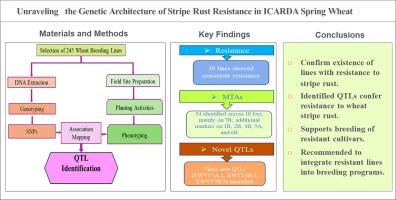ICARDA春小麦抗条锈病遗传结构的研究
IF 1.6
Q3 GENETICS & HEREDITY
引用次数: 0
摘要
条锈病,又称黄锈病,由小麦条锈病(Pst)引起,是影响全球小麦产量的最具破坏性的真菌病害之一。鉴定与Pst抗性相关的遗传位点对于培育耐久的抗Pst小麦品种至关重要。本研究旨在利用15k单核苷酸多态性(SNP)阵列发现小麦抗后叶枯病相关的遗传标记。在两年(2018年和2019年)的时间里,对埃塞俄比亚库卢姆萨农业研究中心国际干旱地区农业研究中心(ICARDA)开发的245个小麦育种品系进行了实地筛选。重要的是,36个育种品系在两个生长季节都表现出一致的免疫力或抵抗力。全基因组关联研究(GWAS)在10个基因座中发现了34个超过显著性阈值的标记-性状关联(mta)。这些SNP标记有一半位于染色体7B上,其余分布在1B、2B、4B、5a和6B染色体上。许多已鉴定的数量性状位点(qtl)与已知的Pst抗性基因/ qtl非常接近,表明它们对应于相同的遗传区域。另外,还有三架qtl - ewyy5a。2, EWYY6B。1、EWYY7B。其中3个位点与先前发现的任何Pst抗性基因都有明显的距离,这是本研究中潜在的新位点。这些qtl是有希望的标记辅助选择候选者,促进了小麦品种对Pst抗性增强的发展。此外,本研究建议将36个一贯抗病品系纳入国家和国际小麦育种计划,以加强Pst疾病管理工作。本文章由计算机程序翻译,如有差异,请以英文原文为准。

Unraveling the genetic architecture of stripe rust resistance in ICARDA spring wheat
Stripe rust, also known as yellow rust, caused by Puccinia striiformis f. sp. tritici (Pst), is among the most destructive fungal diseases affecting global wheat productivity. Identifying genetic loci associated with Pst resistance is crucial for developing durable Pst-resistant wheat varieties. This study aimed to discover genetic markers linked to Pst-resistance in wheat using a 15 K single-nucleotide polymorphism (SNP) array. Field screenings were conducted over two years (2018 and 2019) on a panel of 245 wheat breeding lines developed by the International Center for Agricultural Research in the Dry Areas (ICARDA) at the Kulumsa Agricultural Research Center in Ethiopia. Importantly, 36 breeding lines exhibited consistent immunity or resistance across both growing seasons. Genome-wide association studies (GWAS) identified 34 marker-trait associations (MTAs) across 10 loci that surpassed the significance threshold. Half of these SNP markers were located on chromosome 7B, while the remaining were distributed across chromosomes 1B, 2B, 4B, 5 A, and 6B. Many identified quantitative trait loci (QTLs) were in close proximity to known Pst resistance genes/QTLs, suggesting they correspond to the same genetic regions. Additionally, three QTLs—EWYY5A.2, EWYY6B.1, and EWYY7B.3—were notably distant from any of previously identified Pst resistance genes, emerging as potential novel loci from this study. These QTLs represent promising candidates for marker-assisted selection, facilitating the development of wheat cultivars with enhanced resistance to Pst. Additionally, this study recommends incorporating the 36 consistently resistant lines into national and international wheat breeding programs to enhance Pst disease management efforts.
求助全文
通过发布文献求助,成功后即可免费获取论文全文。
去求助
来源期刊

Plant Gene
Agricultural and Biological Sciences-Plant Science
CiteScore
4.50
自引率
0.00%
发文量
42
审稿时长
51 days
期刊介绍:
Plant Gene publishes papers that focus on the regulation, expression, function and evolution of genes in plants, algae and other photosynthesizing organisms (e.g., cyanobacteria), and plant-associated microorganisms. Plant Gene strives to be a diverse plant journal and topics in multiple fields will be considered for publication. Although not limited to the following, some general topics include: Gene discovery and characterization, Gene regulation in response to environmental stress (e.g., salinity, drought, etc.), Genetic effects of transposable elements, Genetic control of secondary metabolic pathways and metabolic enzymes. Herbal Medicine - regulation and medicinal properties of plant products, Plant hormonal signaling, Plant evolutionary genetics, molecular evolution, population genetics, and phylogenetics, Profiling of plant gene expression and genetic variation, Plant-microbe interactions (e.g., influence of endophytes on gene expression; horizontal gene transfer studies; etc.), Agricultural genetics - biotechnology and crop improvement.
 求助内容:
求助内容: 应助结果提醒方式:
应助结果提醒方式:


